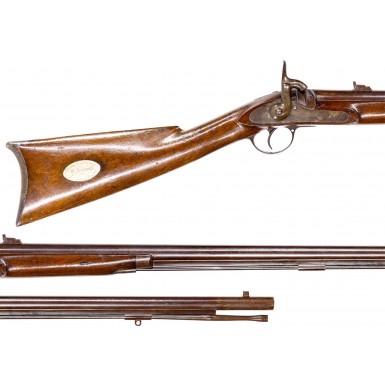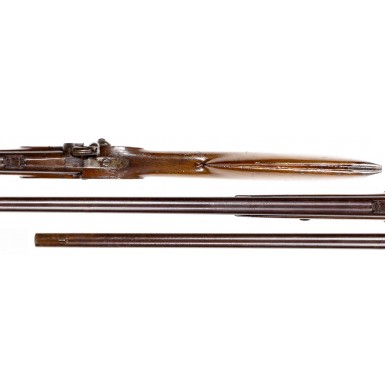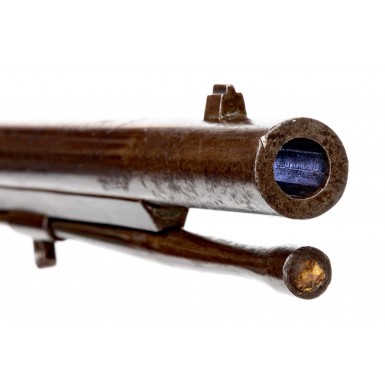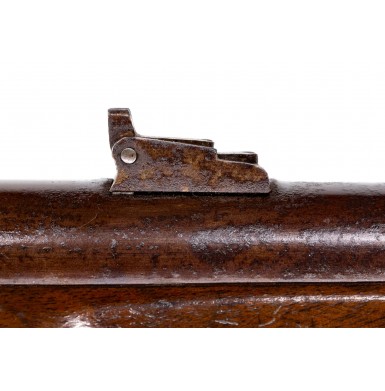Rare Union Continental's Buffalo New York Militia Rifle by P Smith and Named to H Rumrill
- Product Code: FLA-TB619
- Availability: Out Of Stock
-
$5,995.00
On 27 April 1861 a group of prominent citizens in Buffalo, NY organized a new militia company intended to serve any military or defensive needs that might arise in the city with the eruption of the American Civil War. The group was named the Union Continentals and their first elected Captain was Millard Fillmore (1800-1874), the 61-year-old, former 13thPresident of the United States. The group was comprised of a large number of former military officers, civic leaders, politicians and successful businessmen. In fact, an account in the Buffalo Commercial Advertiser from 21 May 1861 noted that the charter members of the group included “four ex-generals of militia, 16 ex-colonels. 33 ex-majors, 60 ex-captains, and 35 honorary members.” The “honorary” members included doctors, lawyers, judges, bankers and a variety of local businessmen. An “initiation fee” of $3 was charged to those who joined, and although the rolls carried 140 official members as of 1 June 1861, another 80 men were listed as members who had not yet paid their dues. Contemporary newspaper accounts noted that the group adopted the “Continental Uniform” which according to the description included a “black frock coat, black cravat or stock, buff military vest, white cotton gloves, black pantaloons and the Continental cocked hat with Union cockade.” Another post-war reminiscence, printed it the local papers, noted that the “company’s membership represented a cash capital of twenty million dollars.” The economic power of $20 million dollars in 1861 would be roughly equivalent to $4.5 billion dollars today, according to the economic value comparison website Measuring Worth.
The membership, like their leader, were almost entirely too old for active military service, with period accounts noting that many of the membership had been born prior to the War of 1812 and with even more born in the 1840s, but still not really young enough to take the field with the New York Volunteer regiments. The roll of the militia group was to provide the types of local services that would have been nice to be handled by actual soldiers, but which at the time were simply not enough soldiers to perform. These included escorting newly formed companies and regiments of soldiers as they passed through town, providing similar services upon their return, marching in a ceremonial capacity for a variety of events. In the early days of their formation, their most important service was to provide security at the State Arsenal where they were engaged in the protect the “public property”. This duty was shared by two other local militia regiments, the Buffalo Tigers and the Buffalo Light Guards. Special Order No 6 Brigadier General Henry L. Lansing, commanding the 31st Brigade of the New York National Guard relieved the three militia groups of that duty in July of 1863. The pinnacle of the Union Continentals history was their service as the honor guard that stood post over the assassinated body of President Abraham Lincoln while he laid in state at St. James Hall in Buffalo during his journey from Washington City (Washington D.C.) to his final resting place in Springfield, IL.
In addition to their unique uniforms that harkened back to their namesake days of the “Continental” Army, the men who served in the elite militia regiment were armed with a special firearm as well. The guns were an interesting composite of New York sporting rifle design and the English Pattern 1853 Enfield Rifle Musket. The 36” round barrels had a distinctly Enfield style curved bolster and were equipped with “military” leaf sight based upon the US 1858 pattern rear sight. The locks were also nominally of Enfield pattern and the guns were equipped with a front sight that was similar to US rifle musket sight with blade mounted on a stud that may have doubled as a socket bayonet lug. Sling swivels were included in the design as well. The balance of the gun was distinctly a sporting arm with a slim varnished half-stock design with a curved sporting buttplate. The lock was secured by a single screw that passed through the lower rear of the breech plug as well. The barrel was secured to the stock via a tang screw, the lock screw and a single wedge and included a sporting-style underlug that ran from the forend tip to within about 3” of the muzzle, leaving enough room to accommodate a socket of a bayonet. The guns had browned barrels with color casehardened locks, hammers and breech plugs with iron furniture which included the buttplate, triggerguard, nose cap, lock screw escutcheon ramrod thimble and entry pipe. A swelled-shank, iron ramrod with a semi-trumpet head tip was secured in the thimbles, beneath the barrel rib. The guns were produced by local Buffalo gunmaker Patrick Smith. Smith primarily produced percussion sporting rifles prior to the order from the Union Continentals and worked in Buffalo from about 1835 until his death in 1881. The guns were marked with Smith’s mark on the top of the breech and with a “serial number” that was stamped on the rear of the breech plug tang and was also stamped on the bottom of the barrel, forward of the breech plug. However, the most notable feature of the arms was the engraved German silver plaque that was mounted on the obverse butt of each of the rifles. This nominally 2” wide and 1” tall oval was engraved in four lines, Union Continental over the name of the member, over the year 1861 and finally M Fillmore Com’dt. The first, third and fourth lines were all engraved in script and were universal on the rifles. The second line, which was the name of the member, was engraved in a Gothic font and was usually the first or first and second initials of the member, followed by their last name.
A number of questions remain unanswered about these guns. The actual number produced is not clear and there is some variation among the extant examples as well as, even the ones that closely conform in overall appearance. The late George Moller hypothesizes that based upon surviving examples that were known to him when he wrote Volume III of American Military Shoulder Arms that no more than 100 of these rifles were produced. This supposition was partially based upon the fact that the highest number on a gun known at that time was 72. The gun offered here is numbered 98, suggesting that at least 100 were produced. Of the guns of this pattern that survive, several calibers are known, suggesting that the member could specify that feature. Gun number 19, described in detail on pages 438-441 of Volume III is listed as .58 caliber, however this gun is .44 and other calibers are known as well. Additionally, at least one other half-stock P Smith marked guns that are similar to these but do not follow the exact “Union Continentals” pattern is known. It is numbered as well and is named to a member of the regiment. However, the gun is more typical of his conventional sporting rifles rather than the Union Continental’s quasi-military pattern arms. The non-conforming gun may indicate that the buyer either did not want to wait for one of the specialty guns to be built or may have opted to buy a cheaper version. It seems that the members purchased these guns themselves, so there was probably quite a bit of variation in how they were delivered. It is also possible that these “presentation” style guns were only ordered for the original charter members who paid their membership fee on 27 April 1861 at the organizational meeting and that the later members were not qualified to obtain what would have certainly been a prized possession for these patriotic men.
Offered here is one of the extremely rare Union Continental’s Rifles by Patrick Smith of Buffalo. This gun is rifle #98 and conforms to the “standard” configuration for these guns, but is .44 caliber, rather than .58. The gun measures nominally 52” in overall length with a 36” round barrel that has a 22” rib mounted under it. The iron mounted half-stock measures 26 ¾” in length. The Patrick Smith interpretation of the US M1858 L-shaped leaf rear sight is mounted 3” from the breech plug and the combination front sight and bayonet lug is mounted 1 ¼” from the muzzle. The Enfield style percussion lock is 5 ¼” in length and is secured with a single screw through an iron escutcheon. Interestingly, #19 as described by Moller has a brass escutcheon. This appears to be another of the small variations found in these rifles. The breech of the rifle is stamped in two lines:
P SMITH
BUFFALO
The marking is deep and strong but is partially obscured when viewed directly because the areas was scraped and cleaned to remove oxidation in an attempt to make the mark clearer. The “serial number” 98 is stamped at the end of the breech plug tang and is also found under the barrel. The German silver plaque is engraved in the traditional fashion for these rifles and reads in four lines:
Union Continental
H. Rumrill.
1861
M. Fillmore Com’dt
A search of the 1860 US Census failed to reveal exactly who this Mr. Rumrill may have been, but a similar search of period Buffalo newspapers suggest that it was Henry Rumrill, who was an architect and would almost certainly have qualified as one of the “honorary” charter members.
The gun remains in about FINE overall condition. It appears to be absolutely correct in all features and is 100% complete with the exception of the sling swivels, which are missing. The gun retains about 20% of the original browned finish on the exterior of the barrel, mixed with a combination of smoothly brown patina and scattered oxidized surface roughness and freckled patches of surface scale. The metal is a combination of smooth surfaces and scattered patches of minor roughness with some pitting here and there, primarily around the breech area where the P SMITH mark is stamped. As noted, this area has been cleaned and scraped to try to make the mark more apparent and to remove surface oxidation, but the cleaning has made the mark a little harder to see if viewed directly but if viewed at an angle the mark is crisp and clear. The serial number on the tang is clearly and deeply stamped as well and the engraved plaque is crisp and clear as well. The lock retains about 30% faded and dulled color casehardening and remains mechanically fine, operating crispy on all positions. The original leaf rear sight is in place and the leaves fold up and down as they should. The original swelled shank iron ramrod is in place as well, but the sling swivels are missing. The bore of the rifle remains in FINEcondition and is mostly bright with crisp rifling. The bore shows some scattered oxidation along its length with some frosting in the grooves. The furniture of the rifle retains some traces of its brown finish with a combination of pewter gray and brown patina with scattered patches of darker surface oxidation, as well as some scattered minor surface roughness. The stock remains in about fine condition as well and retains most of its original finish. The stock has only one condition issue, with a tight crack running from the barrel channel through the single lock screw. This should probably be stabilized with a professional glue repair at some point in time but seems stable currently. Other than this one crack the stock remains very crisp with no indications of having been sanded. The wood does show scattered bumps, dings and mar from handling and use but still retains very sharp edges and is quite crisp overall.
Overall, this is a really great example of a very scarce Buffalo New York Union Continental Militia Rifle by Patrick Smith. The gun remains crisp overall with some very finish remaining and has tons of eye appeal. The rifle is 100% correct and complete with the exception of the missing sling swivels. With only about 100 of these rifles produced and only a handful of extant examples, this is one of those rather scarce rifles that does not appear for sale very often. For any collector of the interesting and often unique secondary long arms of the American Civil War, this is a rifle that you almost certainly do not own. For a collector who specializes in those arms and items that are related to the state of New York, this is a “must have” item. Don’t miss you chance to own the rifle that was likely carried by Henry Rumrill while he stood watch over the body of Abraham Lincoln. Although these guns never saw combat, their history is wonderful and to think that the owner carried this rifle in drill under the commands of the 13th President of the United States and then used it as he stood guard over the body of the 16th President of the United States is somewhat awe inspiring. This is a gun that you really wish could talk to tell you about the events that it witnessed during the Civil War.
Provenance: ex-Anthony (Tony) Daum Collection, ex-Trevor Bovee Collection.
ON HOLD / LAYAWAY
Tags: Rare, Union, Continentals, Buffalo, New, York, Militia, Rifle, by, P, Smith, and, Named, to, H, Rumrill















